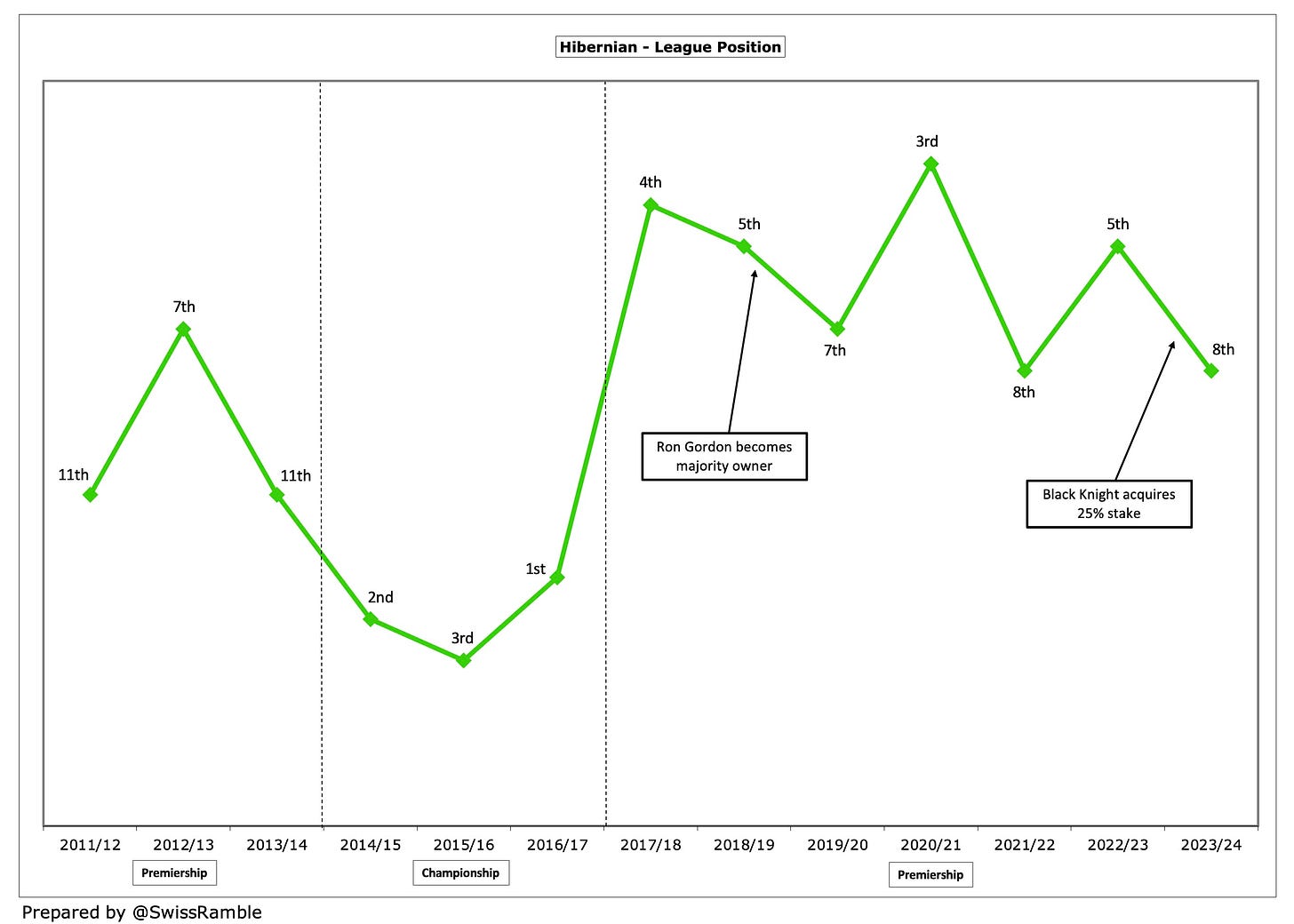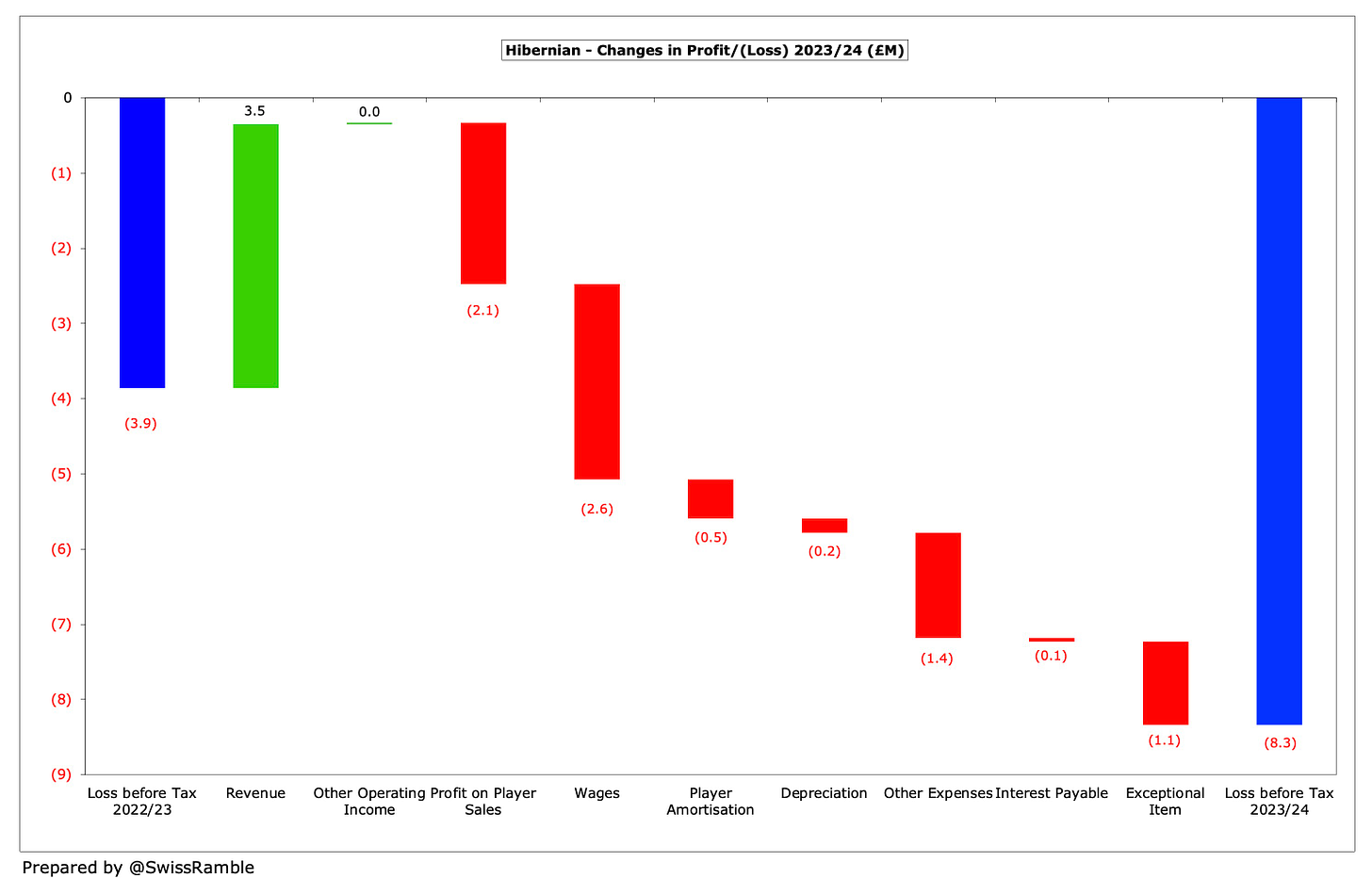Hibernian’s 2023/24 accounts covered a season when the club finished in “a very disappointing eighth position”. However, they did somewhat better in the cup competitions, reaching the quarter-finals of the Scottish Cup and the semi-finals of the League Cup.
They also returned to European competition, where they progressed through two qualifying rounds in the Conference League, before being eliminated by Aston Villa in the play-off round, thus missing out on the group stage.
League Position
This was the second time that Hibernian had finished 8th in the last three seasons, which is clearly below expectations. These are their worst finishes since 2013/14, when they ended up being relegated, spending three seasons in the Championship before returning to the top flight in 2017.
In the seven seasons following promotion, they have finished in the top five on four occasions, including an impressive 3rd place in 2020/21, the first time they had been so high since 2004/05. However, there has been a steep decline in performances on the pitch since then.
Managers
The club has not been helped by frequent changes in the manager with four men being handed the reins after the sacking of Jack Ross in December 2021. Shaun Maloney only lasted four months, while Lee Johnson survived for more than a year before also exiting stage left.
Last season’s lowly finish in the league led to the departure of Nick Montgomery with David Gray taking over after no fewer than three stints as caretaker manager.
Furthermore, chief executive Ben Kensell departed by mutual consent in January after three-and-a-half years in the role.
Owner Ian Gordon acknowledged the issue, “We've created too much instability with the footballing turnover. That's why we are in this position now.”
Ownership
In terms of ownership, there was a lengthy period of stability after Sir Tom Farmer, the former Kwik-Fit CEO, bought the club and the stadium from the receivers in 1991.
During his tenure, the club launched a share issue which allowed supporters to invest in the club. As a result, by June 2019 Hibernian Supporters Limited held 15.5%, while another 17.3% was held directly by supporters.
After 28 years as majority shareholder, Farmer sold his 67.2% controlling stake to American Ron Gordon (Bydand Sports) in July 2019. Tragically, the businessman died from cancer in February 2023, though control of the club remained with the Gordon family in the shape of his wife Kit and son Ian.
A year later the club’s shareholders agreed to new investment from Bill Foley’s Black Knight Football Club UK Limited, who purchased a significant minority stake of 25% for £6m. The Gordon family still hold the majority with 62.3%, though the supporters’ stake was greatly reduced.
Foley also owns Bournemouth, New Zealand club Auckland FC and a significant share in French club Lorient. As a result, Hibernian are the first club in Scotland to be part of a multi-club network.
Former chief executive Ben Kensell said, “It's game changing for Hibs and I think it's quite ground breaking for Scottish football for the nature of a deal of this type. Being part of a multi-club network gives us loads of opportunities around best practice sharing, player trading within the network.”
That said, it looks like there has been some friction in the relationship, as Foley claimed that Hibernian “have not been listening to our input” when recruiting their latest head coach and sporting director.
However, Ian Gordon remains sanguine, “I think the relationship is very strong. I think we are still in the early stages and we're going to see the true benefits in months and years to come.”
Profit/(Loss) 2023/24
Hibernian’s pre-tax loss more than doubled from £3.9m to a club record £8.3m, which the board understandably described as “disappointing”. This was despite revenue rising £3.5m (28%) from £12.4m to £15.9m, a new club high.
There were three reasons for the deterioration in the bottom line:
Operating expenses shot up by £4.7m (24%) from £19.3m to £24.0m.
Profit from player sales was down by two-thirds from £3.2m to £1.0m.
There was an exceptional £1.1m write-off of money owed to the club by a company that went into liquidation.
The loss after tax was smaller at £7.2m after a £1.2m tax credit.
Hibernian don’t break out the individual revenue streams in the published accounts, but the board said that last season’s growth was driven by “an increase in club controlled income, central distributions and donations from shareholders.”
This was boosted by the European qualification, which led to growth in UEFA prize money, as well as ticketing, hospitality and commercial.
Investment in the squad led to a steep increase in staff costs: wages rose £2.6m (26%) from £10.1m to £12.7m, while player amortisation was up £0.5m (34%) from £1.5m to £2.0m. There was also significant growth in other expenses, which climbed £1.4m (21%) from £6.6m to £8.0m.
Not all clubs have published accounts for 2023/24, but Hibernian’s £8.3m loss is the second worst financial result in Scotland to date, albeit less than half of Rangers’ awful £17.3m deficit.
Keep reading with a 7-day free trial
Subscribe to The Swiss Ramble to keep reading this post and get 7 days of free access to the full post archives.







